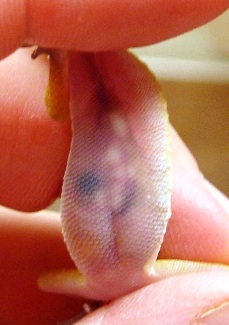"Stick Tail" in Geckos
 "Stick Tail" is a common term used to describe a leopard gecko that loses weight until the tail fat disappears leaving behind a thin boney tail. "Stick tail" also affect fat-tail geckos, tokay geckos, and other species of geckos with robust tails that can store fat. A similar wasting disease is known in crested geckos and other Rhacodactylus, and many other geckos.
"Stick Tail" is a common term used to describe a leopard gecko that loses weight until the tail fat disappears leaving behind a thin boney tail. "Stick tail" also affect fat-tail geckos, tokay geckos, and other species of geckos with robust tails that can store fat. A similar wasting disease is known in crested geckos and other Rhacodactylus, and many other geckos.
"Stick Tail" is not a diagnosis for many different medical problems can cause weight loss in geckos. A “Stick Tail” gecko needs a veterinary exam and diagnostic tests to know what is causing the weight loss. Many sick geckos will have more than one underlying problem. Poor husbandry, poor diet, viral infections, bacterial infections, parasitic infections, sand or moss obstruction, kidney disease, and tumors are common causes of weight loss in leopard geckos. However, cryptosporidiosis is the most common reason a leopard gecko loses weight and you can read more about that disease here.
Flagellated protozoa and bacterial infections of the stomach and intestines are common causes of weight loss. With proper treatment, the outlook is good for leopard geckos with these infections.


Two leopard geckos with liver abscesses. On the left, the red arrows point to two abscesses. The dark object in the center is the gall bladder. On the right, a different gecko with multiple liver abscesses and a visible gall bladder.
The more quickly a leopard gecko with "Stick Tail" is diagnosed and is started on appropriate treatment, the more likely that it will respond to treatment. Unfortunately, there are some conditions, such as liver abscesses, that will not improve despite treatment.



